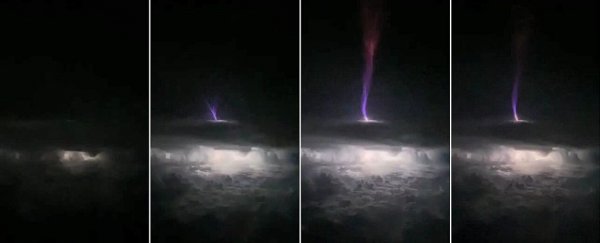One of the most powerful and fascinating forces of nature is born of storms: great cracks of light that part the sky, flicking vast amounts of electricity into the surrounding atmosphere, cracking into the ground whenever it reaches it.
Or that's how we typically think of lightning.
But the phenomenon has another manifestation, only relatively recently revealed: sometimes, it erupts upwards from the clouds, lashing into the stratosphere in a tremendous blue 'jet' of electricity.
Little is known about this phenomenon; it's unpredictable and occurs beyond the sight of most people, above a layer of storm clouds.
But, thanks to a citizen scientist, one such giant jet was recorded above the clouds during a storm in Oklahoma in 2018 – and, with data collected by other instruments, scientists have been able to study it in detail in three dimensions.
The result gives us new details on this strange phenomenon, which should contribute to a better understanding of how and why it happens.
"We were able to map this gigantic jet in three dimensions with really high-quality data," said physicist and engineer Levi Boggs of the Georgia Tech Research Institute.
"We were able to see very high frequency (VHF) sources above the cloud top, which had not been seen before with this level of detail. Using satellite and radar data, we were able to learn where the very hot leader portion of the discharge was located above the cloud."
Captured on a low-light Watec camera on the night of 14 May 2018, the lightning jet was enormous, a huge discharge that was clearly visible in the footage captured.
When Boggs learnt of the footage, he immediately went looking for data from other instruments that may have captured the event. And there was a bonanza.
 The Watec video of the lightning jet. (Kevin Palivec)
The Watec video of the lightning jet. (Kevin Palivec)
The jet was in range of and had been recorded by a nearby VHF lightning mapping system called the Lightning Mapping Array, two NCEI Next Generation Weather Radar (NEXRAD) locations, and instruments on NOAA's Geostationary Operational Environmental Satellite (GOES).
This wealth of data meant that Boggs and his colleagues were able to conduct an in-depth analysis reconstructing the complexities of the bolt.
"The fact that the gigantic jet was detected by several systems, including the Lightning Mapping Array and two geostationary optical lightning instruments, was a unique event and gives us a lot more information on gigantic jets," said physicist and engineer Doug Mach of the Universities Space Research Association (USRA).
"More importantly, this is probably the first time that a gigantic jet has been three-dimensionally mapped above the clouds with the Geostationary Lightning Mapper (GLM) instrument set."
The data revealed that the jet was, truly, a colossus. It propagated from clouds with a maximum altitude of about 8 kilometers (5 miles) to altitudes around ten times that height – nearly as far as the Kármán line, where Earth's atmosphere ends and outer space begins.
As it did so, it transported around 300 coulombs of electrical charge into the upper atmosphere; a typical cloud-to-cloud or cloud-to-ground lightning bolt only transports around 5 coulombs.
The team was also able to ascertain that the leaders – the channels of ionized air along which the lightning discharge can be seen – were extremely hot, over 4,700 degrees Celsius (8,500 Fahrenheit). Meanwhile, the smaller plasma streamers were significantly cooler, around 200 degrees Celsius (400 Fahrenheit).
These streamers started propagating just above the cloud top, the team found, traveling to the lower ionosphere, at an altitude of around 80 kilometers. This creates an electrical connection between the cloud tops and the ionosphere, transferring a negative charge at a rate of thousands of amperes per second.
The different instruments revealed that the optical component of the jet remained relatively close to the cloud top, at an altitude of 15 to 20 kilometers. The VHF emission, however, was detected much higher, at altitudes of 22 to 45 kilometers.
"The VHF and optical signals definitively confirmed what researchers had suspected but not yet proven, that the VHF radio from lightning is emitted by small structures called streamers that are at the very tip of the developing lightning, while the strongest electric current flows significantly behind this tip in an electrically conducting channel called a leader," said engineer Steve Cummer of Duke University.
However, a lot of questions yet remain. It's still unclear why jets shoot upwards when most lightning is directed down, or sideways. The researchers believe that there may be something blocking the lightning from traveling downwards or towards other clouds.
Although the Oklahoma storm was not the usual type associated with jets, as it occurred at high latitudes, rather than the tropics, and occurred at an unusual time of year, it could yield a clue here. Very little downward lightning was observed before the release of the giant jet.
"For whatever reason, there is usually a suppression of cloud-to-ground discharges," Boggs explained.
"There is a buildup of negative charge, and then we think that the conditions in the storm top weaken the uppermost charge layer, which is usually positive. In the absence of the lightning discharges we normally see, the gigantic jet may relieve the buildup of excess negative charge in the cloud."
Let's hope future jets contain the answers.
The research has been published in Science Advances.
